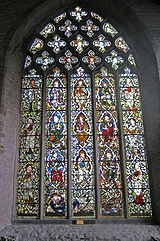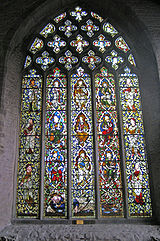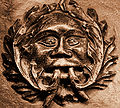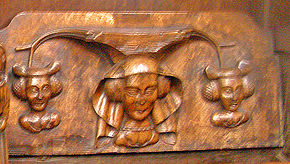
St Laurence Church, Ludlow
Encyclopedia

Parish church
A parish church , in Christianity, is the church which acts as the religious centre of a parish, the basic administrative unit of episcopal churches....
in the Church of England
Church of England
The Church of England is the officially established Christian church in England and the Mother Church of the worldwide Anglican Communion. The church considers itself within the tradition of Western Christianity and dates its formal establishment principally to the mission to England by St...
in Ludlow
Ludlow
Ludlow is a market town in Shropshire, England close to the Welsh border and in the Welsh Marches. It lies within a bend of the River Teme, on its eastern bank, forming an area of and centred on a small hill. Atop this hill is the site of Ludlow Castle and the market place...
.
Background
The parish church was established as a NormanNormans
The Normans were the people who gave their name to Normandy, a region in northern France. They were descended from Norse Viking conquerors of the territory and the native population of Frankish and Gallo-Roman stock...
place of worship in association with the founding of Ludlow
Ludlow
Ludlow is a market town in Shropshire, England close to the Welsh border and in the Welsh Marches. It lies within a bend of the River Teme, on its eastern bank, forming an area of and centred on a small hill. Atop this hill is the site of Ludlow Castle and the market place...
in the 11th century AD. This parish church in Shropshire
Shropshire
Shropshire is a county in the West Midlands region of England. For Eurostat purposes, the county is a NUTS 3 region and is one of four counties or unitary districts that comprise the "Shropshire and Staffordshire" NUTS 2 region. It borders Wales to the west...
, England
England
England is a country that is part of the United Kingdom. It shares land borders with Scotland to the north and Wales to the west; the Irish Sea is to the north west, the Celtic Sea to the south west, with the North Sea to the east and the English Channel to the south separating it from continental...
contains an extensive set of misericord
Misericord
A misericord is a small wooden shelf on the underside of a folding seat in a church, installed to provide a degree of comfort for a person who has to stand during long periods of prayer.-Origins:...
s in the choir
Choir
A choir, chorale or chorus is a musical ensemble of singers. Choral music, in turn, is the music written specifically for such an ensemble to perform.A body of singers who perform together as a group is called a choir or chorus...
stalls as well as fine stained glass windows. The tower is 42 meters in height and commands expansive views of the local area. The church was rebuilt in the year 1199 and has had several later additions and modifications.
History
Original Norman traces were found beneath the south porch, indicating some extant foundations exist from the 11th century AD. After its initial construction the church was expanded and rebuilt in 1199 to accommodate a growing town population. In the late Middle AgesMiddle Ages
The Middle Ages is a periodization of European history from the 5th century to the 15th century. The Middle Ages follows the fall of the Western Roman Empire in 476 and precedes the Early Modern Era. It is the middle period of a three-period division of Western history: Classic, Medieval and Modern...
considerable wealth accrued to the town based upon the wool
Wool
Wool is the textile fiber obtained from sheep and certain other animals, including cashmere from goats, mohair from goats, qiviut from muskoxen, vicuña, alpaca, camel from animals in the camel family, and angora from rabbits....
trade. Correspondingly the church underwent several further additions in that era. The major works occurred between 1433 and 1471 with a virtual re-building of the nave, tower and chancel elements The tower took on a Perpendicular style which was the preferred style of the late 15th century in England
England
England is a country that is part of the United Kingdom. It shares land borders with Scotland to the north and Wales to the west; the Irish Sea is to the north west, the Celtic Sea to the south west, with the North Sea to the east and the English Channel to the south separating it from continental...
. The Saint John
John the Evangelist
Saint John the Evangelist is the conventional name for the author of the Gospel of John...
's Chapel on the north side was the chapel of the Palmers Guild, which thrived in the Late Middle Ages
Late Middle Ages
The Late Middle Ages was the period of European history generally comprising the 14th to the 16th century . The Late Middle Ages followed the High Middle Ages and preceded the onset of the early modern era ....
. The Palmers' Window within St John's Chapel illustrates the legend of King Edward the Confessor and St John the Evangelist by eight panels and was inspired by the Ludlow Palmers’ 13th century pilgrimage to the Holy Land
Holy Land
The Holy Land is a term which in Judaism refers to the Kingdom of Israel as defined in the Tanakh. For Jews, the Land's identifiction of being Holy is defined in Judaism by its differentiation from other lands by virtue of the practice of Judaism often possible only in the Land of Israel...
.

The church is a member of the Greater Churches Group
Greater Churches Group
The Greater Churches Network is a self-help organisation within the Church of England. There are currently 32 churches within the Greater Churches Network....
.
Architecture
The dominant exterior feature is the square bell towerBell tower
A bell tower is a tower which contains one or more bells, or which is designed to hold bells, even if it has none. In the European tradition, such a tower most commonly serves as part of a church and contains church bells. When attached to a city hall or other civic building, especially in...
, which houses the historic and famed bells of the church. The chancel
Chancel
In church architecture, the chancel is the space around the altar in the sanctuary at the liturgical east end of a traditional Christian church building...
contains the mediaeval choir stalls adorned with numerous misericord
Misericord
A misericord is a small wooden shelf on the underside of a folding seat in a church, installed to provide a degree of comfort for a person who has to stand during long periods of prayer.-Origins:...
s. Many of these fine wood carving
Wood carving
Wood carving is a form of working wood by means of a cutting tool in one hand or a chisel by two hands or with one hand on a chisel and one hand on a mallet, resulting in a wooden figure or figurine, or in the sculptural ornamentation of a wooden object...
s are of heraldry
Heraldry
Heraldry is the profession, study, or art of creating, granting, and blazoning arms and ruling on questions of rank or protocol, as exercised by an officer of arms. Heraldry comes from Anglo-Norman herald, from the Germanic compound harja-waldaz, "army commander"...
and others are genre scenes of common life. Typical sizes of the misericords and upper bench carvings are 25 centimeters wide by 12 centimeters high; the carvings have very deep relief (up to two centimetres). Some of the elements of the carving are repeated on roof adornments.

Church monument
A church monument is an architectural or sculptural memorial to a dead person or persons, located within a Christian church. It can take various forms, from a simple wall tablet to a large and elaborate structure which may include an effigy of the deceased person and other figures of familial or...
s, most of which contain the remains of people involved with Ludlow Castle
Ludlow Castle
Ludlow Castle is a large, partly ruined, non-inhabited castle which dominates the town of Ludlow in Shropshire, England. It stands on a high point overlooking the River Teme...
’s Council of the Marches
Welsh Marches
The Welsh Marches is a term which, in modern usage, denotes an imprecisely defined area along and around the border between England and Wales in the United Kingdom. The precise meaning of the term has varied at different periods...
. Other than the large chancel east window, there are other notable windows within the chancel; the most remarkable one depicts the Ten Commandments
Ten Commandments
The Ten Commandments, also known as the Decalogue , are a set of biblical principles relating to ethics and worship, which play a fundamental role in Judaism and most forms of Christianity. They include instructions to worship only God and to keep the Sabbath, and prohibitions against idolatry,...
, illustrating six of the commandments being broken.
The hexagonal south porch derives from the 14th century and serves as the main entrance to the church; this porch is one of only three of such a six-sided design in all of England. The other interior chapels are St Catherine
Catherine of Alexandria
Saint Catherine of Alexandria, also known as Saint Catherine of the Wheel and The Great Martyr Saint Catherine is, according to tradition, a Christian saint and virgin, who was martyred in the early 4th century at the hands of the pagan emperor Maxentius...
’s Chapel and the Lady Chapel, the latter of which has a large filled-in door that was once used for the Ludlow fire engine at an earlier era. Exterior features include a memorial plaque to the poet
Poet
A poet is a person who writes poetry. A poet's work can be literal, meaning that his work is derived from a specific event, or metaphorical, meaning that his work can take on many meanings and forms. Poets have existed since antiquity, in nearly all languages, and have produced works that vary...
A. E. Housman
A. E. Housman
Alfred Edward Housman , usually known as A. E. Housman, was an English classical scholar and poet, best known to the general public for his cycle of poems A Shropshire Lad. Lyrical and almost epigrammatic in form, the poems were mostly written before 1900...
and the Samuel Burgess Memorial Garden. Above the interior stone lantern
Lantern
A lantern is a portable lighting device or mounted light fixture used to illuminate broad areas. Lanterns may also be used for signaling, as 'torches', or as general light sources outdoors . Low light level varieties are used for decoration. The term "lantern" is also used more generically to...
there is s splendid vault.
Notable burials
The ashes of A. E. HousmanA. E. Housman
Alfred Edward Housman , usually known as A. E. Housman, was an English classical scholar and poet, best known to the general public for his cycle of poems A Shropshire Lad. Lyrical and almost epigrammatic in form, the poems were mostly written before 1900...
are buried in the church grounds, with the stump of a cherry tree
Cherry Tree
Cherry Tree may refer to:* A tree that produces cherries* An ornamental cherry tree that produces cherry blossomsPlaces* Cherry Tree, Pennsylvania, a borough in Indiana County, Pennsylvania, United States* Cherry Tree, Oklahoma...
marking their location. Ambrosia Sidney, (1565-1574), sister of Sir Philip Sidney and Mary Sidney
Mary Sidney
Mary Herbert , Countess of Pembroke , was one of the first English women to achieve a major reputation for her literary works, poetry, poetic translations and literary patronage.-Family:...
who died at Ludlow Castle, aged nine, is buried near the altar under an impressive memorial bearing the arms of Sir Henry Sidney, (1530-1586), President of the Council of Wales and the Marches. His heart was brought from Worcester where he died and buried in a small leaden urn in an oratory near his daughter's tomb. The rest of his remains were buried with his wife Mary Dudley
Mary Dudley, Lady Sidney
Mary Sidney , Lady Sidney was an English lady-in-waiting at the court of Elizabeth I, and the mother of the courtier and poet Sir Philip Sidney...
at Penhurst, Kent.
Contents

Nave
In Romanesque and Gothic Christian abbey, cathedral basilica and church architecture, the nave is the central approach to the high altar, the main body of the church. "Nave" was probably suggested by the keel shape of its vaulting...
and aisle
Aisle
An aisle is, in general, a space for walking with rows of seats on both sides or with rows of seats on one side and a wall on the other...
area, there are several noteworthy contents, including:
- The royal EnglishEnglandEngland is a country that is part of the United Kingdom. It shares land borders with Scotland to the north and Wales to the west; the Irish Sea is to the north west, the Celtic Sea to the south west, with the North Sea to the east and the English Channel to the south separating it from continental...
coat of armsCoat of armsA coat of arms is a unique heraldic design on a shield or escutcheon or on a surcoat or tabard used to cover and protect armour and to identify the wearer. Thus the term is often stated as "coat-armour", because it was anciently displayed on the front of a coat of cloth...
from the year 1628. - Wall hanging: A Shropshire LadA Shropshire LadA Shropshire Lad is a cycle of sixty-three poems by the English poet Alfred Edward Housman . Some of the better-known poems in the book are "To an Athlete Dying Young", "Loveliest of Trees, the Cherry Now" and "When I Was One-and-Twenty".The collection was published in 1896...
located near the south door. - The west window illustrating some of the historical figures involved with Ludlow CastleLudlow CastleLudlow Castle is a large, partly ruined, non-inhabited castle which dominates the town of Ludlow in Shropshire, England. It stands on a high point overlooking the River Teme...
.
Organ
In the north transept is the John SnetzlerJohn Snetzler
John Snetzler was an organ builder of Swiss origin who worked mostly in England.He was born in Schaffhausen, in 1710 and died in Schaffhausen, 28 September 1785...
organ. Through the generosity of Henry Arthur Herbert, 1st Earl of Powis, this organ was installed in 1764 at a cost of £1,000. Originally it was located in a gallery beneath the tower and had three manuals with 19 stops.
In the 19th century, Gray and Davison
Gray and Davison
Gray & Davison was a large-scale manufacturer of church and cathedral pipe organs, based in London. The company was active between 1841–1973 and had its heyday between 1905–1930....
restored the organ and enlarged it, at the same time moving it to its present position in the North Transept. By this time, a fourth manual had been added.
The organ was restored in the 1980s by Nicholson & Co (Worcester) Ltd
Nicholson & Co (Worcester) Ltd
Nicholson & Co Ltd is a company that manufactures pipe organs.The Nicholson's were a family of organ builders originating from Rochdale, Lancashire in the North of England. When John Nicholson moved to Worcester in 1841 he obtained permission from the Dean and Chapter of Worcester Cathedral to...
.
In 2006, thanks largely to a grant from the Heritage Lottery Fund
Heritage Lottery Fund
The Heritage Lottery Fund is a fund established in the United Kingdom under the National Lottery etc. Act 1993. The Fund opened for applications in 1994. It uses money raised through the National Lottery to transform and sustain the UK’s heritage...
, further work was carried out to clean the interior, improve the console, and to add a rank of pipes.
List of organists
- Edmund White ca. 1473
- Thomas Sherman 1492 - 1508
- John Perche ca. 1493
- Maurice Phillips ca. 1551
- John Broke ca. 1549 - 1559
- Thomas Tanner ca. 1566
- Thomas Cope 1568 - 1579
- John Cooke 1578 - 1583
- John Harrison 1584 - 1597
- George Pingle 1597 - 1604
- Richard Crumpe 1605 - 1620
- Benjamin Cosyn 1621 - 1622
- Mr. Perkings 1623
- Marmaduke Pardoe 1623 - 1626
- Walter Gibbs 1626 - 1628
- Edward Smith 1627 - 1630
- Edward Standley 1630 - 1634
- John Maylard 1634 - 1635
- Berkeley Wrench 1636 - 1637 (then organist of Gloucester CathedralGloucester CathedralGloucester Cathedral, or the Cathedral Church of St Peter and the Holy and Indivisible Trinity, in Gloucester, England, stands in the north of the city near the river. It originated in 678 or 679 with the foundation of an abbey dedicated to Saint Peter .-Foundations:The foundations of the present...
before reappointment in 1642). - John ap Evan 1638
- Thomas Heardson 1637 - 1642
- Berkeley Wrench 1642 - 1645
- interregnum 1645 - 1672
- Benjamin Moone 1672 - 1704
- Henry Hall 1704 - 1707
- William Hine 1707
- Josias Preist 1708 - 1711
- John Childe 1711 - 1712
- John Salter 1712 - 1713
- Benjamin Sharrett 1713 - 1716
- David Langton 1716 - 1730
- David Valentine 1730 - 1764
- Joseph Harris 1764 - 1771 (then organist of St Martin in the Bull RingSt Martin in the Bull RingThe church of St Martin in the Bull Ring in Birmingham 5, England is a parish church in the Church of England.-Background:It is the original parish church of Birmingham. It stands between the Bull Ring shopping centre and the markets. The church is a Grade II* listed building. The current Rector...
, Birmingham) - Miles Coyle 1771 - 1789 (then organist of Hereford CathedralHereford CathedralThe current Hereford Cathedral, located at Hereford in England, dates from 1079. Its most famous treasure is Mappa Mundi, a mediæval map of the world dating from the 13th century. The cathedral is a Grade I listed building.-Origins:...
) - John Clarke WhitfieldJohn Clarke WhitfieldJohn Clarke Whitfield , English organist and composer, was born at Gloucester, and educated at Oxford under Dr Philip Hayes....
1789 - 1794 (later organist of St Patrick's Cathedral, Armagh (Church of Ireland)) - Charles Evans 1794 - 1823
- Adam Ree 1823 - 1841 - 1851 - 1856
- Miss Francis Ree 1856 - 1858
- William Walter Ridley 1858
- Robert Bartholomew 1858 - 1891
- Joseph Humphrey Anger 1892 - 1893 (then Instructor of Harmony and Theory at the Royal Conservatory of MusicRoyal Conservatory of MusicThe Royal Conservatory of Music is a music school and performance venue in Toronto, Canada. Other uses of the term include:*The Madrid Royal Conservatory, Spain*The Royal Academy of Music, London, United Kingdom...
, TorontoTorontoToronto is the provincial capital of Ontario and the largest city in Canada. It is located in Southern Ontario on the northwestern shore of Lake Ontario. A relatively modern city, Toronto's history dates back to the late-18th century, when its land was first purchased by the British monarchy from...
) - Ivor AtkinsIvor AtkinsSir Ivor Algernon Atkins was the choirmaster and organist at Worcester Cathedral for over 50 years . He is well known for editing Allegri's Miserere with the famous top-C part for the treble...
1893 - 1897 (then organist of Worcester CathedralWorcester CathedralWorcester Cathedral is an Anglican cathedral in Worcester, England; situated on a bank overlooking the River Severn. It is the seat of the Anglican Bishop of Worcester. Its official name is The Cathedral Church of Christ and the Blessed Mary the Virgin of Worcester...
) - Clement Charlton PalmerClement Charlton PalmerClement Charlton Palmer was an cathedral organist, who served at Canterbury Cathedral.-Background:Clement Charlton Palmer was born on 26 April 1871 in Barton-under-Needwood in Staffordshire. His father, Dr. Clement Palmer, was the local general practitioner.He was educated at the Derby School of...
1897 - 1908 (then organist of Canterbury CathedralCanterbury CathedralCanterbury Cathedral in Canterbury, Kent, is one of the oldest and most famous Christian structures in England and forms part of a World Heritage Site....
) - Norman Charles Woods 1908 - 1911 (then organist of St. Michael's College, TenburySt. Michael's College, TenburyThe College of St. Michael and All Angels, in Tenbury Wells Worcestershire was a boys school founded by Frederick Ouseley in 1856 to provide a model for the performance of Anglican church music. Choral services were performed daily in term time, and the college possessed a library that contained...
) - Harold Carpenter Lumb StocksHarold Carpenter Lumb StocksHarold Carpenter Lumb Stocks was an English cathedral organist, who served in St Asaph Cathedral-Background:Harold Carpenter Lumb Stocks was born on 21 October 1884 in Essendon, Hertfordshire...
1911 - 1917 (then organist of St Asaph CathedralSt Asaph CathedralSt Asaph Cathedral is the Anglican cathedral in St Asaph, Denbighshire, north Wales. It is sometimes claimed to be the smallest Anglican cathedral in Britain.- History :...
) - Frank Edgar Bastick 1917 - ca. 1921 - 1948
- Edgar Sydney Landen 1948 - 1951
- Gilbert W. Whitehouse 1951 - 1970
- Richard J. E. Francis 1971 - 1974
- George Baker 1974 - 1976
- Keith Anthony Morgan 1976 - 1978
- Morwen Byram-Wigfield 1978 - 1980
- Richard J. E. Francis 1980 - 2007
- Shaun Ward 2007 - current

